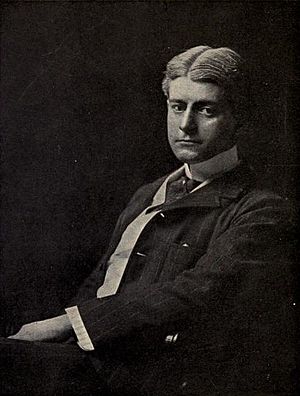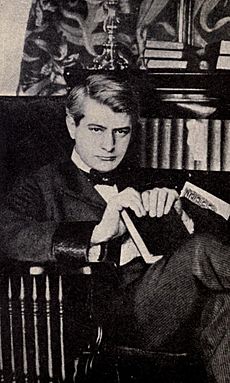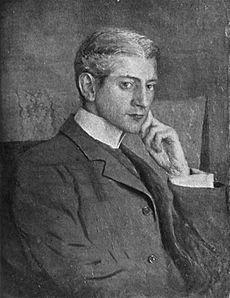Frank Norris facts for kids
Quick facts for kids
Frank Norris
|
|
|---|---|

Portrait of Norris, by Arnold Genthe
|
|
| Born | Benjamin Franklin Norris Jr. March 5, 1870 Chicago, Illinois, U.S. |
| Died | October 25, 1902 (aged 32) San Francisco, California, U.S. |
| Pen name | Justin Sturgis |
| Occupation | Writer |
| Nationality | American |
| Alma mater | University of California, Berkeley |
| Notable works | McTeague: A Story of San Francisco, The Octopus: A Story of California |
| Spouse | Jeannette Black |
| Children | Jeannette Williamson Norris |
Benjamin Franklin Norris Jr. (born March 5, 1870 – died October 25, 1902) was an American writer. He was a journalist and wrote novels during a time called the Progressive Era. His stories often showed a style known as naturalism.
Some of his most famous books include McTeague: A Story of San Francisco (1899), The Octopus: A Story of California (1901), and The Pit (1903).
Contents
Life of Frank Norris
Frank Norris was born in Chicago, Illinois, in 1870. His father, Benjamin, was a successful businessman. His mother, Gertrude, had been an actress.
In 1884, his family moved to San Francisco. His father then worked in real estate. After his brother passed away and a short time in London, young Norris went to Académie Julian in Paris in 1887. He studied painting there for two years. During this time, he learned about the naturalist novels of Émile Zola.
Between 1890 and 1894, he attended the University of California, Berkeley. There, he learned about the ideas of human evolution from Darwin and Spencer. These ideas later appeared in his writings. His stories were published in the student magazine at Berkeley and in the San Francisco Wave.
After his parents divorced, he moved east. He spent a year studying English at Harvard University. He met Lewis E. Gates there, who encouraged him to write more.
Norris worked as a news reporter in South Africa from 1895 to 1896 for the San Francisco Chronicle. Then, he was an editorial assistant for the San Francisco Wave from 1896 to 1897. In 1898, he worked for McClure's Magazine as a war reporter in Cuba during the Spanish–American War. In 1899, he joined the publishing company Doubleday & Page in New York City.
While at the University of California, Berkeley, Norris was part of the Phi Gamma Delta fraternity. He also helped start the Skull & Keys society. Because of a prank he was involved in, an annual dinner for his fraternity is still named after him.
In 1900, Frank Norris married Jeannette Black. They had a child in 1902.
Norris passed away in San Francisco on October 25, 1902. He was only 32 years old. He died from an infection caused by a burst appendix. His big series of books, The Epic of the Wheat trilogy, was left unfinished. He is buried in Mountain View Cemetery in Oakland, California.
His younger brother, Charles Gilman Norris, also became a well-known novelist and editor. Charles was married to the famous writer Kathleen Norris. The Bancroft Library at the University of California, Berkeley, keeps the writings and papers of all three authors.
Frank Norris's Career
Frank Norris's books often show the struggles caused by powerful companies. These companies were sometimes unfair and greedy around the turn of the 20th century.
In his novel The Octopus: A Story of California, a railroad company causes problems for many ranchers in Southern California. At the end of the book, after a fight between farmers and railroad workers, readers are asked to see a "larger view." This view suggests that even through hardship, things will eventually work out for the best.
Another novel, Vandover and the Brute, was written in the 1890s but published after he died. It tells the story of three college friends. One of them faces ruin because of a difficult lifestyle.
Norris's writing style is often compared to other famous authors. These include Stephen Crane, Theodore Dreiser, and Edith Wharton.
Frank Norris's Legacy
- Norris's novel The Pit was turned into a play in 1904. It was also made into a film in 1917.
- His short story "A Deal in Wheat" (1903) and the novel The Pit inspired the 1909 film A Corner in Wheat.
- Moran of the Lady Letty was adapted into a film in 1922. This movie starred Rudolph Valentino.
- Norris's book McTeague has been made into two films. The most famous one is Greed from 1924.
- In 1962, the Frank Norris Cabin was named a National Historic Landmark. This means it's a very important historical place.
- An opera based on his novel McTeague was performed in 1992.
- In 2008, the Library of America chose Norris's newspaper article "Hunting Human Game" for a collection of American true crime stories.
- An alley in San Francisco is named after him, called Frank Norris Place.
- A tavern on Polk Street in San Francisco is named McTeague's Saloon. It's decorated to match his novel McTeague.
- A popular saying, "I hate writing, but love having written," is believed to come from a letter Norris wrote about writing advice. This letter was published after he died.
Works by Frank Norris
Fiction
- (1892). Yvernelle.
- (1898). Moran of the "Lady Letty": A Story of Adventure Off the California Coast.
- (1899). McTeague: A Story of San Francisco.
- (1899). Blix.
- (1900). A Man's Woman.
- (1901). The Octopus: A Story of California.
- (1903). The Pit: A Story of Chicago.
- (1903). A Deal in Wheat and Other Stories of the New and Old West.
- (1906). The Joyous Miracle.
- (1909). The Third Circle.
- (1914). Vandover and the Brute.
- (1931). Frank Norris of "The Wave." Stories & Sketches From the San Francisco Weekly, 1893 to 1897.
- (1998). The Best Short Stories of Frank Norris.
Non-fiction
- (1898). The Surrender of Santiago.
- (1903). The Responsibilities of the Novelist.
- (1986). Frank Norris: Collected Letters.
- (1996). The Apprenticeship Writings of Frank Norris 1896–1898.
Collected works
- The Complete Works of Frank Norris. 1898–1903 (4 Vols.)
- Complete Works of Frank Norris. 1903 (7 Vols.)
- The Collected Works of Frank Norris. 1928 (10 Vols.)
- Norris: Novels and Essays. 1986.
- A Novelist in the Making: A Collection of Student Themes, and the Novels Blix and Vandover and the Brute. 1970
See also
 In Spanish: Frank Norris para niños
In Spanish: Frank Norris para niños



